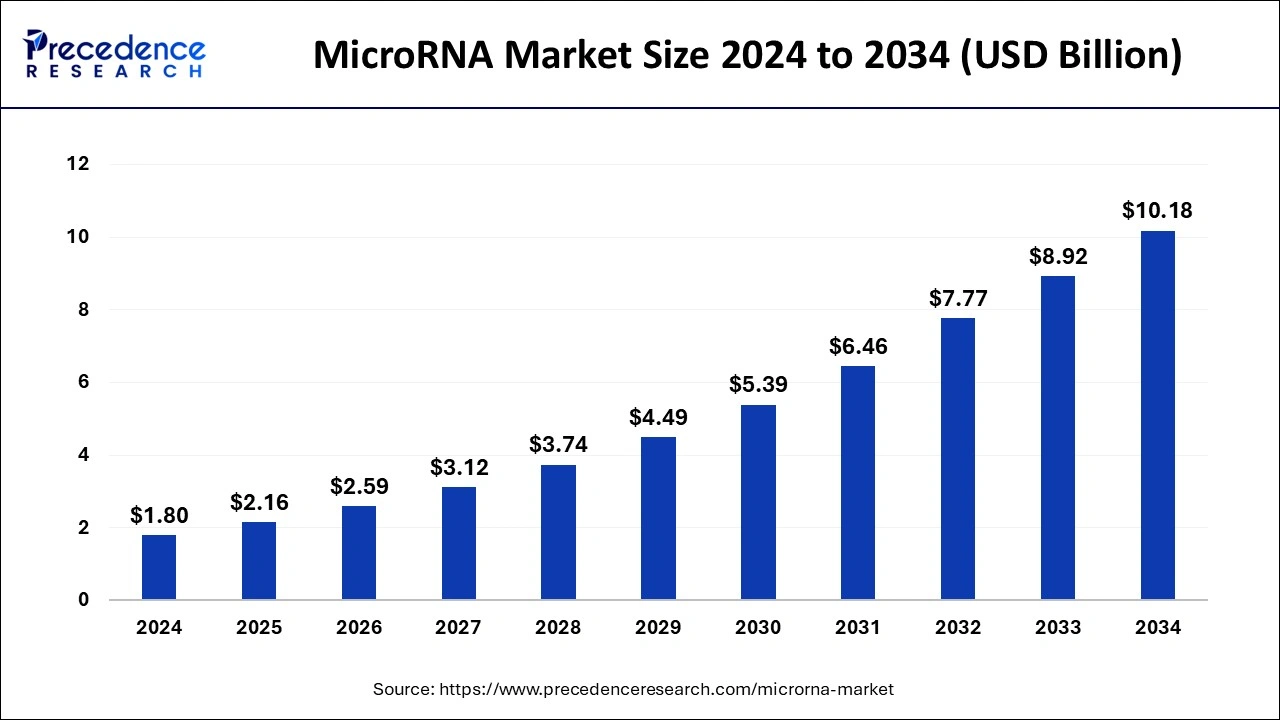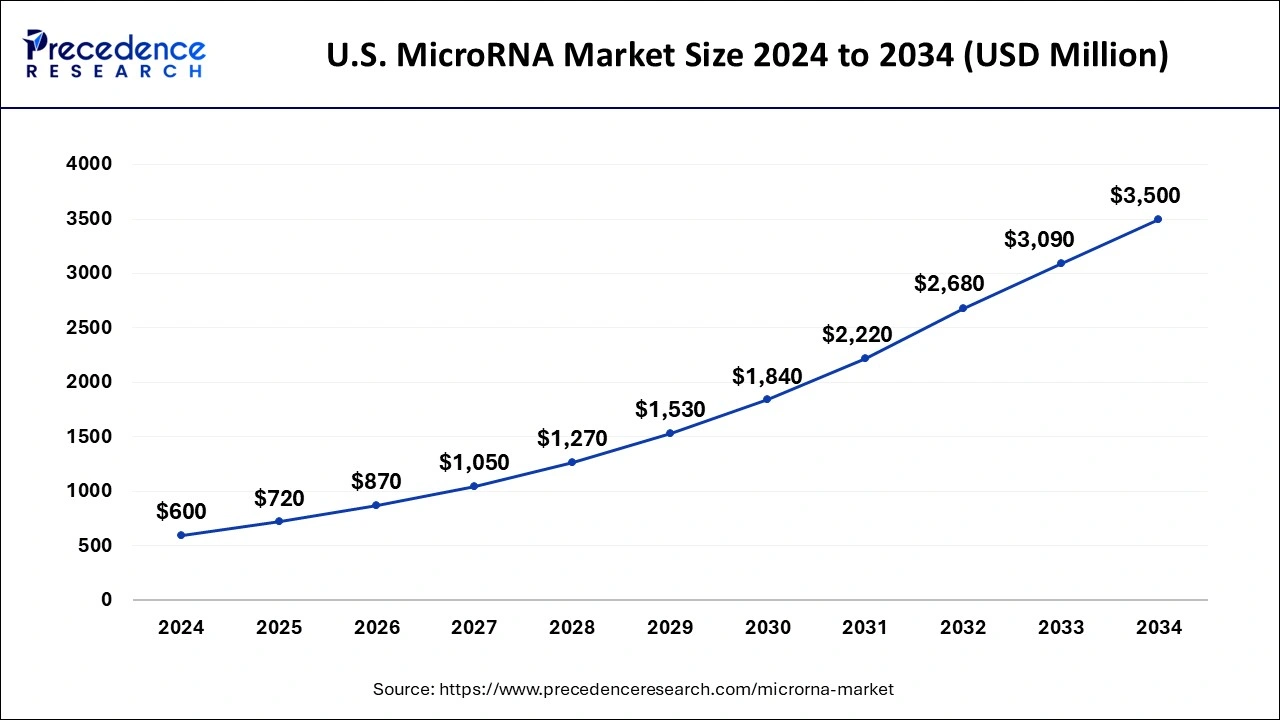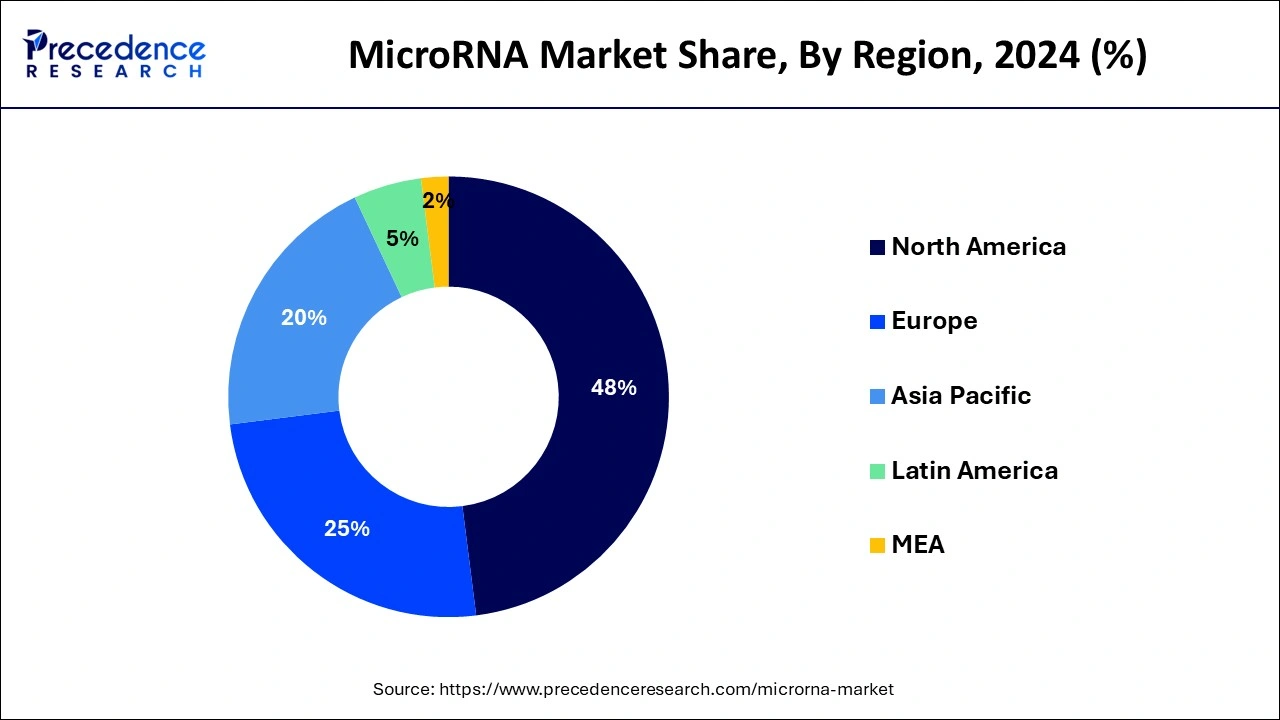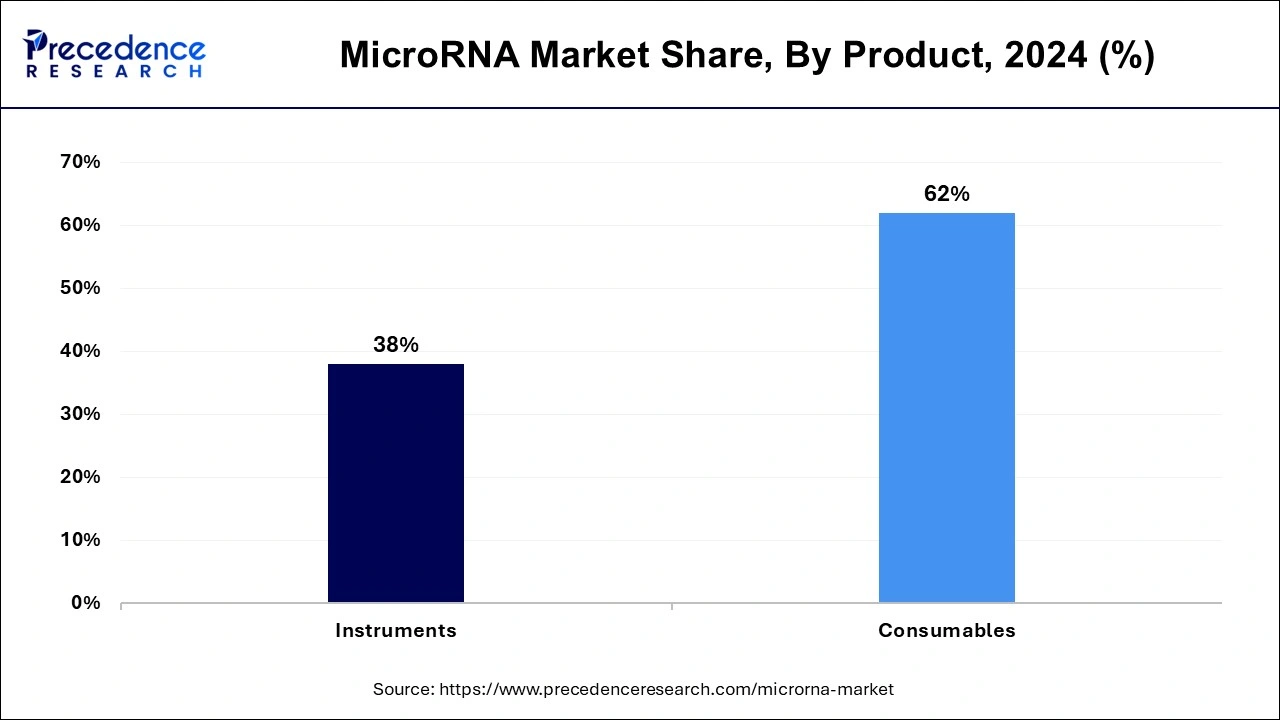The global microRNA market size is calculated at USD 2.16 billion in 2025 and is predicted to surpass around USD 10.18 billion by 2034, accelerating at a CAGR of 18.92% from 2025 to 2034. The North America microRNA market size surpassed USD 860 million in 2024 and is expanding at a CAGR of 18.96% during the forecast period. The market sizing and forecasts are revenue-based (USD Million/Billion), with 2024 as the base year.
The global microRNA market size was valued at USD 1.80 billion in 2024, and it is projected to surpass around USD 10.18 billion by 2034, poised to grow at a CAGR of 18.92% during the forecast period from 2025 to 2034.

The U.S. microRNA market size reached USD 600 million in 2024 and is anticipated to be worth around USD 3,500 million by 2034, poised to grow at a CAGR of 19.29% from 2025 to 2034.

North America dominated the global microRNA market in 2024; the region will maintain its dominance over the global market during the forecast period owing to the rising investments in research and development activities in the region. Moreover, the presence of significant players that carry the potential to invest in R&D activities contributes to the market’s growth in North America.
Along with the significant developments, the availability of smooth and rapid procedures to get approvals for microRNA biomarkers in the region supplements the market's growth. The market in North America is elevated by massive contributors such as Thermo Fisher Scientific, Synlogic, ProMega Corporation, and SeqMatic.

On the other hand, Asia Pacific is expected to witness the fastest growth during the forecast period. The region’s rapidly increasing population, rising prevalence of cardiovascular diseases, increased demand for microRNA-based therapies, and growing emphasis on research and development activities are a few factors that propel the growth of the market.
For instance, in September 2022, headquartered in Singapore, MiRXES announced its collaboration with the National University Heart Centers and National Heart Center, Singapore, in order to manage pulmonary hypertension. Under the collaboration, the organizations have collectively launched Southeast Asia’s first multi-center study with early detection microRNA biomarkers. The center aims to use microRNA biomarkers to detect pulmonary hypertension at an early stage.
The microRNA market revolves around the products and services related to microRNA research and applications. MicroRNA molecules play a regulatory role in gene expression. They are also involved in multiple biological processes linked to developing and progressing diseases such as cancer, cardiovascular disorders, and other neurological diseases. The global microRNA market involves a wide range of products and services, including research tools, diagnostic kits, and services for microRNA profiling and analysis.
The market for microRNA is being further stimulated by the ongoing quest for novel therapeutic compounds that can function as new medications for biopharmaceutical companies. Several miRNA-based possibilities, including anti-miRNA substances and particular miRNA inhibitors, are undergoing clinical studies and could serve as effective therapeutic options.
Consequently, RNA therapeutics is viewed as a hot investment sector that will result in the creation of successful medicines. Technology advancements made to improve the selectivity and sensitivity of miRNA detection have also led to an increase in the market for microRNA. RCA-based methods, DSN-based techniques, LAMP-based techniques, and enzyme-free amplification are a few of the recently developed methods for miRNA identification.
The utilization of microRNA as a biomarker is increasing in this sector. MiRNA biomarkers are particularly critical in genome-wide studies and data-driven methodologies because they outperform more conventional methods in terms of reproducibility and power. They are thus excellent candidates for the development of biomarkers. The significance of miRNAs for the development and discovery of biomarkers has also grown as a result of the rising popularity of liquid biopsies.
| Report Coverage | Details |
| Growth Rate from 2025 to 2034 | CAGR of 18.92% |
| Market Size in 2025 | USD 2.16 Billion |
| Market Size by 2034 | USD 10.18 Billion |
| Largest Market | North America |
| Base Year | 2024 |
| Forecast Period | 2025 to 2034 |
| Segments Covered | By Products, By Services, By Application, and By End Use |
| Regions Covered | North America, Europe, Asia-Pacific, Latin America, and Middle East & Africa |
Rising diagnostic potential
MicroRNA has shown promise as a biomarker to detect and monitor multiple diseases. They carry the ability to detect specific microRNA signatures associated with diseases which provides an opportunity to detect any disease at an early stage. The rising demand for better diagnostic outcomes fuels the demand for microRNA in the market by acting as a major driver for the market’s growth.
Traditional diagnostic methods often demand invasive procedures which is also quite time-consuming. Whereas microRNA-based diagnostic procedures offer non-invasive methods. Thus, the comfort, reduced risks of complications, and monitoring advantages offered by microRNA-based diagnostic processes boost the growth of the market.
The market of microRNA is affected by the high cost
As a result, the high cost of the equipment needed to identify miRNA and the labor-intensive testing procedures increase the overall study value. The market's expansion may be hampered by an elevated failure rate and a lack of highly qualified experts with extensive industry experience. Due to the high price of kits and chemicals, which raises the overall cost of experiments and research, untrained professionals are unable to execute the test, which impacts research costs. Utilizing cutting-edge technology like microarrays and NGS enhances the research price since highly qualified experts are needed to operate this equipment precisely and carry out the experiments by protocol. Accordingly, the cost of the microRNA market is increasing as a result of the fundamental analysis, which acts as a significant restraint for the market to grow.
Higher utilization as a biomarker adoption
The effort to increase the availability of novel drugs due to the progressive use of advanced biomarker applications Due to their higher robustness and reproducibility than conventional approaches, these biomarkers are particularly crucial in genome-wide population research and data-driven methodologies. As a result, these compounds provide promising therapeutic candidates for the creation of biomarkers. Additionally, growing interest in liquid-based biopsies has raised their significance in the identification and future development of biomarkers. The possibility of using microRNA biomarkers for prognosis, treatments, and diagnosis to support market expansion has also been studied as research activities have increased steadily.
The instrument segment is further segmented in real-time PCR, next-generation sequencing (NGS), and microarrays. By the instrument, the real-time PCR segment has acquired a significant share of the market. Real-time PCR offers a cost-effective solution for miRNA analysis compared to some other high-throughput techniques. Real-time PCR is often used in conjunction with other miRNA analysis techniques, such as microarray analysis or miRNA sequencing. It serves as a validation tool to confirm and quantify miRNA expression data obtained from other platforms. This compatibility and complementarity with other techniques further contribute to the leading position of real-time PCR in the miRNA market.

Consumables is another lucrative segment of the global microRNA market. Consumables are typically used on a per-experiment or per-sample basis. Researchers often perform multiple experiments and process numerous samples, requiring a significant number of consumables. The repetitive nature of miRNA research, combined with the need for consistent and reliable results, drives the demand for consumables.
The isolation and purification segment carries the largest share of the global microRNA market. Obtaining high-quality and pure miRNA samples is crucial for accurate downstream analysis and research outcomes. Service providers specializing in isolation and purification offer standardized protocols and quality control measures to ensure consistent and reliable results. They have optimized workflows and access to state-of-the-art equipment, enabling efficient and reproducible extraction and purification of miRNAs. The field of miRNA research is rapidly evolving, with new methodologies and technologies being developed. The adoption of advanced technologies for isolation and purification services boosts the segment’s growth.
The cancer segment held the dominating share of the market in 2024, the segment will maintain its significance during the forecast period. The rising demand for early-stage diagnosis for cancer patients has supported the segment’s growth. MicroRNAs work as a biomarker during the diagnostic procedures that allow the rapid diagnosis of cancer by reducing the risk of false/pseudo-outcomes, this element acts as a supplementing factor for the segment’s growth.
Cancer is one of the leading causes of mortality across the globe, as the healthcare industry focuses on the development of rapid and advanced diagnostic procedures for cancer, the demand for microRNA will grow subsequently.
On the other hand, the infectious diseases segment is expected to be the most lucrative segment of the market during the forecast period. The segment has started gaining significance since the sudden outbreak of Covid-19. The major clinical application of microRNA for infectious diseases promotes the growth of the segment. Various microRNA expressions help in improving infectious disease outcomes, this element is expected to promote the segment’s growth.
The academic and government research institutes segment held the dominating share of the market, the segment will continue to show a significant increase during the forecast period. Academic and government research institutes often collaborate with each other and with other stakeholders, such as pharmaceutical companies, to advance microRNA research. These collaborations promote knowledge sharing, resource pooling, and interdisciplinary research, ultimately accelerating scientific progress and translating findings into practical applications.
MicroRNAs provide a fascinating area of study for scientists interested in gene regulation, molecular biology, and cellular processes. Investigating miRNAs helps expand our knowledge of gene regulatory networks, RNA biology, and the intricate mechanisms underlying cellular function.
By Products
By Services
By Application
By End Use
By Geography
For inquiries regarding discounts, bulk purchases, or customization requests, please contact us at sales@precedenceresearch.com
No cookie-cutter, only authentic analysis – take the 1st step to become a Precedence Research client